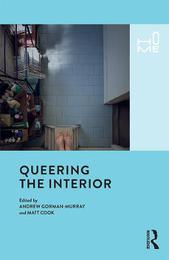
|
Queering the Interior
Paperback / softback
Main Details
| Title |
Queering the Interior
|
| Authors and Contributors |
Edited by Andrew Gorman-Murray
|
|
Edited by Matt Cook
|
| Physical Properties |
| Format:Paperback / softback | | Pages:256 | | Dimensions(mm): Height 234,Width 156 |
|
| ISBN/Barcode |
9781350116313
|
| Classifications | Dewey:306.766 |
|---|
| Audience | | Tertiary Education (US: College) | |
|---|
|
Publishing Details |
| Publisher |
Bloomsbury Publishing PLC
|
| Imprint |
Bloomsbury Academic
|
| Publication Date |
30 May 2019 |
| Publication Country |
United Kingdom
|
Description
Queering the Interior problematizes the familiar space of 'home'. It deploys a queer lens to view domestic interiors and conventions and uncovers some of the complexities of homemaking for queer people.Each of the book's six sections focuses on a different room or space inside the home. The journey starts with entryways, and continues through kitchens, living spaces, bedrooms, bathrooms, and finally, closets and studies. In each case up to three specialists bring their disciplinary expertise and queer perspectives to bear. The result is a fascinating collection of essays by scholars from literary studies, geography, sociology, anthropology, history and art history. The contributors use historical and sociological case studies; spatial, art and literary analyses; interviews; and experimental visual approaches to deliver fresh, detailed and grounded perspectives on the home and its queer dimensions. A highly creative approach to the analysis of domestic spaces, Queering the Interior makes an important contribution to the fields of gender studies, social and cultural history, cultural studies, design, architecture, anthropology, sociology, and cultural geography.
Author Biography
Matt Cook is Professor of Modern History at Birkbeck University, UK. Andrew Gorman Murray is Lecturer in Geography and Urban Studies at Western Sydney University, Australia.
ReviewsInsisting that queer world-making took place even in the domestic spaces most intimately associated with heteronormativity, the gloriously multi-disciplinary essays in this volume illuminate the queer uses and meanings of interior space, the formation of queer interiority, and the complex and often vexed relationship between queer taste, gender, the culture of consumption, and the space of the home. A compelling and highly original intervention. * George Chauncey, Columbia University, USA and author of Gay New York (1994). * In this rich and timely volume, Andrew Gorman-Murray and Matt Cook-and the wide range of interdisciplinary authors they have assembled here-take us on a very queer tour of the home. From kitchens, living rooms, bedrooms, bathrooms, closets and studies, they highlight the complexity of queer homemaking. These micro-geographies chart-and critique-- normativities through public and private spheres of domestic space in ways that will surely have wide appeal. * Michael Brown, University of Washington, USA. * From bedsits to bedrooms, closets to garden courtyards, the intimate essays in Queer Interiors evoke the slippery identities of rooms and the people who live in them. In asking what makes domesticity queer, this book provides its readers with many remarkable insights into the hidden meanings of familiar spaces.? * Chris Brickell, Otago University, New Zealand * Queering the Interior invites readers in to a series of rooms, not just closets but hallways, nurseries, living rooms, kitchens, bathrooms and bedrooms. Each chapter is a rich case study that brings queer theory to life. It is refreshing to read a series of interdisciplinary essays that extend thinking well beyond idealized domestic norms. The collection is a' must have' for anyone interested in issues of sex, gender, space and place. * Robyn Longhurst, University of Waikato, New Zealand. * The inside echoes the outside. The home inscribes social and power relations but also allows the expression of difference. In this insightful exploration of queer domestic spaces, Andrew Gorman-Murray and Matt Cook take us across the threshold of this most private space and through many of the rooms that make up homes across the developed world. They and their contributors allow us to peer into the lightened corners of domesticity, subversion and pleasure. * Louise Johnson, Deakin University, Australia *
|